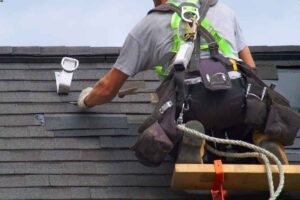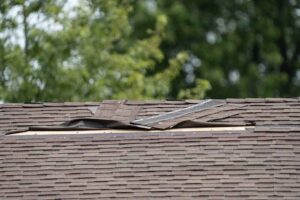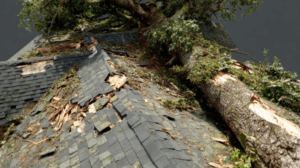October in North Carolina is a month of change—the air sharpens, leaves shift from green to gold, and storm systems roll through faster than you can rake them up. It’s also when strong fall winds start sweeping across the Sandhills and central part of the state, turning peaceful neighborhoods into cleanup zones overnight.
At Red Wolf Roofing, we’ve seen it all: heavy branches piercing rooftops, shingles ripped loose by sudden gusts, and entire sections of gutter pulled down by wind-driven debris. The transition from summer to winter brings unpredictable weather, and those “harmless” fall storms can hit your roof harder than you’d think.
When a big gust knocks down a tree limb or throws debris across your shingles, time is of the essence. The longer your roof stays exposed, the greater your risk for leaks, interior damage, and expensive structural repairs.
The good news? Knowing what to do—and what not to do—immediately after a storm can make all the difference. Let’s walk through how to assess, respond, and recover safely when October’s winds leave your roof in rough shape.
The Reality of Fall Wind Events in North Carolina
Autumn storms might not have the name recognition of hurricanes or ice events, but they’re often just as damaging. These systems bring short bursts of high-speed winds, heavy rain, and falling debris—especially after months of summer growth.
The Sandhills and Piedmont regions are particularly vulnerable because of their mix of mature hardwoods and open spaces. Strong gusts can easily snap dead branches or topple weakened trees, sending them straight onto rooftops, fences, and driveways.
Unlike summer storms that dump rain for hours, these wind events strike fast and hard. That’s why homeowners often don’t realize how bad the damage is until the next morning—when water spots appear on the ceiling or shingles are scattered across the yard.
When that happens, quick and careful action matters most.
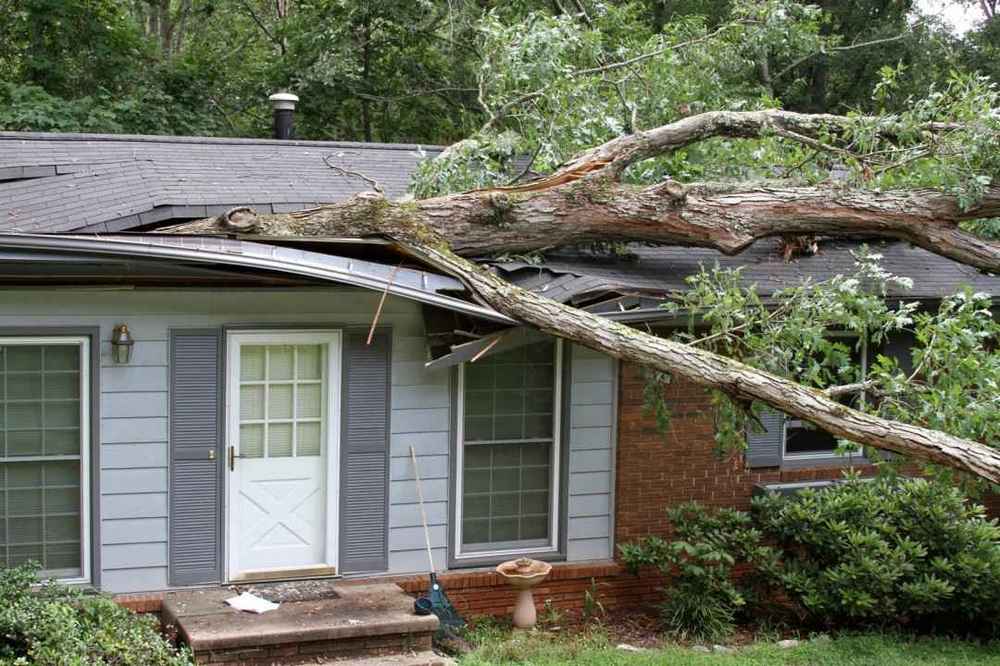
Step One: Safety First—Before You Inspect Anything
After a windstorm, it’s natural to want to grab a ladder and start assessing the damage. But safety should always come first. Roofs can be slippery, unstable, and dangerous after a storm.
Here’s what you should do instead:
- Stay on the ground. Use binoculars or your phone’s zoom to inspect from a safe distance.
- Avoid power lines. Downed lines may be hidden under branches or debris—never assume they’re dead.
- Watch for structural hazards. If a large branch or tree has fallen on your home, evacuate until professionals verify that it’s safe.
- Keep kids and pets inside. Sharp debris, nails, and broken glass are common after storms.
- Document the scene. Take clear photos and videos before cleanup begins—this helps with insurance claims later.
Once you’ve confirmed your safety, you can move on to assessing the damage and protecting your home from further harm.
Step Two: Identify the Type and Extent of Roof Damage
Not all storm damage looks the same. Sometimes it’s obvious—a massive hole from a fallen limb or visible missing shingles. But other times, the danger hides beneath the surface, slowly causing leaks or rot.
Here’s what to look for:
- Missing or lifted shingles: These are clear signs that wind has broken the seal or torn shingles away entirely.
- Damaged flashing: Check around chimneys, vents, and roof valleys for bent or missing metal flashing.
- Fallen branches or debris: Even small branches can puncture shingles or crack underlayment.
- Granule loss: Check gutters or downspouts for piles of shingle granules—this signals wear and tear from debris impact.
- Gutter displacement: Strong winds can twist or tear gutters away from fascia boards, preventing proper drainage.
- Interior leaks or water stains: Water spots on ceilings or walls often mean roof damage above that area.
Remember: just because your roof looks fine from the street doesn’t mean it escaped unscathed. Some of the worst problems hide under the shingles or in the attic.
Step Three: Prevent Further Damage with Temporary Fixes
If your roof’s been compromised, even slightly, water can make a bad situation worse fast. That’s why temporary protection is critical while waiting for a professional repair.
If it’s safe to do so (and only if you’re comfortable), here are a few short-term measures to minimize water intrusion:
- Tarp damaged areas: Use heavy-duty tarps secured with boards or sandbags—not nails—to prevent leaks.
- Clear loose debris: Safely remove small branches that could roll into gutters or puncture the roof further.
- Cover exposed wood: If shingles or decking are missing, cover them to keep rain out.
- Empty overflowing gutters: Standing water adds extra weight and can worsen leaks during follow-up storms.
If you’re unsure how to safely perform these steps, call a roofing professional immediately. At Red Wolf Roofing, we provide emergency response for exactly this reason—because every hour counts when water is finding its way in.
Step Four: Know When to Call for Emergency Roof Repairs
There’s a difference between a few missing shingles and damage that puts your home at real risk. You should call for emergency roof repairs if:
- A tree or large branch has struck your roof.
- You see daylight through the attic or ceiling.
- Water is actively dripping inside your home.
- You spot sagging areas on the roof surface.
- There’s significant damage to flashing, ridge caps, or vents.
When our Red Wolf Roofing team responds to an emergency call, we focus first on stabilizing the situation—securing tarps, sealing vulnerable areas, and preventing further water intrusion. From there, we conduct a full inspection and prepare a detailed repair plan tailored to your roof’s condition and materials.
Our goal isn’t just to patch things up—it’s to restore long-term integrity so you won’t be back in the same situation after the next storm.
Step Five: Filing an Insurance Claim the Smart Way
Dealing with roof damage is stressful enough without worrying about paperwork. Fortunately, if your roof was damaged by a storm, your homeowner’s insurance may cover the repairs.
Here’s how to navigate the process efficiently:
- Document everything: Include photos, timestamps, and notes about when the storm occurred.
- Contact your insurance company promptly: Delays can complicate claims or affect coverage.
- Schedule a professional inspection: We can provide a detailed report that helps justify your claim.
- Avoid quick, cheap fixes: Some storm chasers show up offering low-cost repairs but disappear when problems reappear. Work only with licensed, insured local roofers.
- Keep all receipts: Temporary repairs, tarps, and cleanup costs can sometimes be reimbursed.
At Red Wolf Roofing, we frequently assist homeowners through this process, helping ensure your claim is properly supported with the documentation insurers look for.
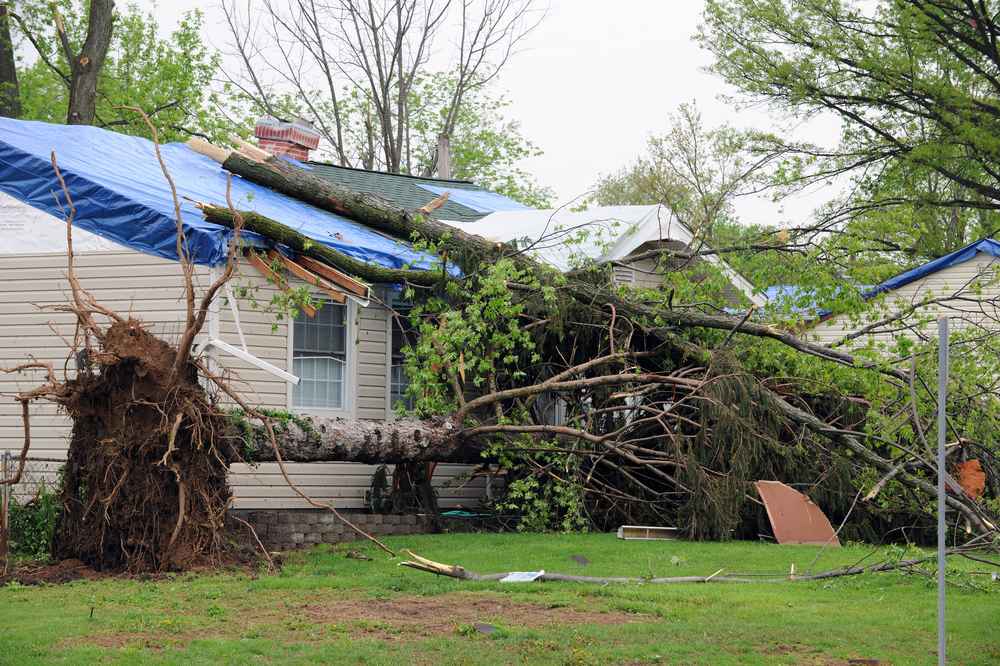
Step Six: Clean Up Safely and Prevent Future Damage
Once the immediate crisis is handled, it’s time to clean up and prepare for what’s next. Clearing debris doesn’t just restore your yard—it protects your roof and gutters from additional problems.
Here’s a quick checklist for safe cleanup:
- Wear gloves and sturdy shoes to avoid cuts and punctures.
- Dispose of broken branches properly—don’t drag them across your shingles.
- Clear leaves, twigs, and debris from gutters and downspouts.
- Trim nearby trees to prevent repeat incidents in future windstorms.
- Schedule a post-repair inspection to ensure no hidden damage remains.
We also recommend a yearly fall roof inspection to identify weak points before the next major weather event. Reinforcing flashing, resealing vents, and replacing aged shingles all go a long way in making your home more storm-resilient.
Why October Wind Events Hit Harder Than You Think
There’s a reason fall storms cause so much trouble in North Carolina. By October, trees are heavy with both leaves and brittle branches. When strong winds roll through, those weakened limbs snap easily—and they don’t always fall straight down.
Combine that with the remnants of tropical systems that still pass through the Southeast, and you’ve got a recipe for unpredictable, fast-moving storms that cause widespread roof damage in just a few minutes.
The best defense? Preparation and professional inspection. The earlier you identify vulnerable areas—like loose flashing, lifted shingles, or clogged valleys—the better your roof will hold up when the next windstorm hits.
The Red Wolf Roofing Difference
When storms hit, you want a team that knows what to look for, how to act fast, and how to restore your roof’s integrity—not just cover it up.
At Red Wolf Roofing, we’re a local North Carolina company with years of experience navigating the state’s unpredictable fall weather. We understand the urgency of post-storm response and the importance of doing repairs the right way—safely, thoroughly, and built to last.
Our emergency roofing services include:
- Rapid response for storm or wind damage
- Temporary tarping and sealing to prevent leaks
- Comprehensive inspection reports for insurance claims
- Full repair and restoration using top-quality materials
- Preventive maintenance to strengthen your roof for future storms
We don’t cut corners, and we don’t leave homeowners guessing. Our goal is to restore your peace of mind—because when the wind howls again, you deserve to know your home is protected.
Act Fast, Stay Safe, and Call the Pros
When October’s winds take aim at North Carolina, they don’t always give much warning. But how you respond afterward makes all the difference between a quick recovery and months of frustration.
Start by staying safe, documenting everything, and securing your home from further damage. Then call a trusted local roofer to assess, repair, and reinforce your roof for the storms still to come.
At Red Wolf Roofing, we’re here when you need us most—ready to respond fast, work efficiently, and stand behind every repair we make.
If your roof took a beating during this season’s wind events, don’t wait until leaks show up or ceilings start to stain. Contact Red Wolf Roofing today for a professional inspection and emergency repair service. We’ll get your home back to strong—before the next gust blows through.

